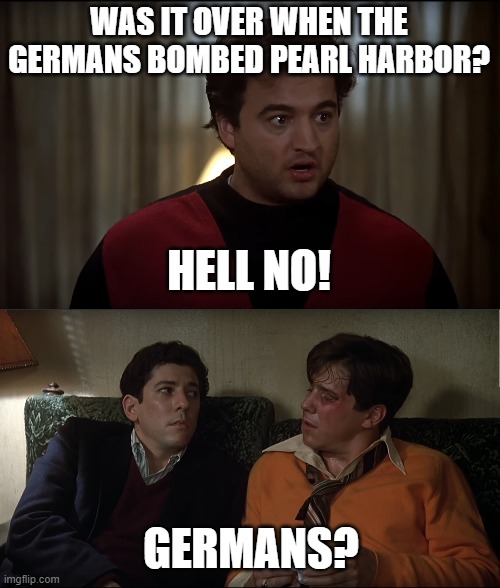
Click here: to donate by Credit Card
Or here: to donate by PayPal
Or by mail to: Free Republic, LLC - PO Box 9771 - Fresno, CA 93794
Thank you very much and God bless you.
Posted on 08/25/2025 5:25:00 AM PDT by whyilovetexas111

|
Click here: to donate by Credit Card Or here: to donate by PayPal Or by mail to: Free Republic, LLC - PO Box 9771 - Fresno, CA 93794 Thank you very much and God bless you. |
Could be
Exposed
Our whole military needs more smaller cheaper stuff
But the MIC doesn’t like that
The rare these days educational free republic thread
Well done
Just ask Japan.
“DON’T TOUCH THEIR BOATS”
Check out Habitual Line Crosser on YouTube or whatever media you have. He’s hilarious, but there are cuss words.
When did Afghanistan attack any of our boats?

Given that the Navy can't even maintain its existing fleet, such damage would put the carrier out of operation for years.
Multiple such attacks, by surprise at the beginning of a war, could knock out a large proportion of our surface warships for the duration of the war.
The Navy has no effective plans for its own survival, let alone victory, in a war with China which starts with a Chinese surprise attack.
AI says 200 miles and 6 hrs on an eM2 Freightliner, whatever that is.
Yes I was extending your comment, not arguing against it!
“A dozen+ drones from a nearby Chinese freighter would ignite the deck park and do so much damage to the control tower, and particularly to its antennas, to make the carrier itself a mission kill.”
US Navy aircraft carriers are defended against drones by a layered system that includes dedicated interceptor drones, such as Anduril’s Roadrunner-M and Raytheon’s Coyote Block 2, which are launched from escorting destroyers. These systems address the “cost-curve problem” by offering a cheaper way to counter cheap drones than using expensive missiles. Other defenses include traditional Close-In Weapon Systems (CIWS), directed energy weapons like high-energy lasers, and emerging directed energy systems like the LEONIDAS microwave system, providing a multi-layered approach to defense against drone threats.
https://www.google.com/search?q=us+aircraft+carrier+drone+defense+system

Ummm...
Kind of like the Monitor obsoleted an entire fleet of wooden ships. Change is constant as technology advances!
Also, as soon as the Chinese freighter launched its first drone, there would be 4 to 8 Harpoons in the air headed to the Chinese freighter.
I would expect a couple of torpedoes would also be en route to the Chinese freighter.
So pretty much unacceptable. 200 miles on a refrigerated truck that takes 6 hrs to recharge. That would be 9 hours to go 200 miles and recharge, then another 9 for the next 200 miles.
Farmland in the midwest to NYC is 1500 miles. That’s 7.5 200-mile increments, each requiring 9 hours. 67 hours, no sleep. 24 hour days, but there are sleep regulations.
Hmm that looks like just under 3 days enroute, and if we toss in sleep, I think it’s scaring a week (or more since the fridge has to run while asleep).
As opposed to diesel with 5 minute refills and idles at night for the fridge.
This looks like a fail.
But we don’t want that, do we?
Ike warned us about the MIC.
Trump has to deal with the Deep State.
It's all related. America is an Empire, not a Republic.
America voted for Trump so we want to be a Republic again.
But is it possible? Probably not.
Perhaps, but hypersonic ship-killing missiles are a different matter.
The Battle Off Samar is a famous WWII battle where a tiny task force of jeep carriers, destroyers, and destroyer escorts, “Taffy 3”, battled a heavy Japanese fleet of battleships and cruisers until the IJN admiral abandoned the engagement.
This is often attributed to the ferocity of the attack by the small US Navy warships. “The Last Stand of the Tin Can Sailors” is a great account of this battle.
But the guys of The Unauthorized History of the Pacific War on YouTube say that there is more to the story.
There were no US Navy fleet carriers nearby. But there were more jeep carriers than just the ones that were in Taffy 3. And the total US combat aircraft available to attack the IJN Center Fleet was maybe 400 airplanes. They just kept attacking non-stop.
Big fleet carriers make juicy targets. Hit one and you’ve inflicted a lot of damage. A fleet of small carriers could be harder to put out of business.
” How was America “vulnerable” because of George Washington’s “isolationist” foreign policy as it was the overwhelming norm prior to 1941? It wasn’t. “
Really? Let’s drop the Marxists analysis of history. Isolationism has never been, with one or two rare exceptions, the “norm.”
Rather than wave about broad assertions of our history, let’s look at the wars and alliances:
George Washington’s war, the American revolution was fought to establish control over the eastern seaboard past the Appalachians to the Mississippi River. This was acquired against the native peoples, French and the British.
The Northwest Indian wars (1785 – 1795) sought to take control away from Indian nations of the Ohio region.
War of 1812-1815 we fought to conquer and annex Canada.
Seminole wars of 1817-1858, against Spain to conquer Florida
Mexican American war 1846 – 1848 fought against Mexico to acquire California, Nevada, Utah, Arizona, New Mexico, Colorado, Wyoming.
The Texas Revolution and acquisition of Texas from Mexico by 1845
Spanish-American war of 1898 to acquire Puerto Rico, Guam and the Philippines from Spain.
Control of the Panama Canal zone 1903
As a result of World War II US gain temporary control of Germany, Austria, Japan, South Korea, and various Pacific islands.
United States has entered into the following regional/bilateral defense treaties:
ANZUS (Australia, New Zealand, United States Security Treaty, 1951–present)
Originally a trilateral defense pact. Since the 1980s, New Zealand has a looser role, so the U.S. mainly partners with Australia.
U.S.–Japan Security Treaty (1951/1960–present)
Allows U.S. forces in Japan; obligates the U.S. to defend Japan if attacked.
U.S.–South Korea Mutual Defense Treaty (1953–present)
Signed after the Korean War; U.S. military bases remain in South Korea.
U.S.–Philippines Mutual Defense Treaty (1951–present)
Recently reinvigorated due to tensions in the South China Sea.
U.S.–Thailand (1954–present, under SEATO legacy and later bilateral)
Still active, though less prominent.
Rio Pact (Inter-American Treaty of Reciprocal Assistance, 1947–present)
Collective defense treaty with many Latin American countries.
AUKUS (Australia–United Kingdom–United States, 2021–present)
Focused on advanced military tech sharing, including nuclear-powered submarines.
Quad (Quadrilateral Security Dialogue: U.S., Japan, India, Australia)
Not a formal military alliance, but a strategic security partnership aimed at balancing China in the Indo-Pacific.
Five Eyes (U.S., UK, Canada, Australia, New Zealand)
Disclaimer: Opinions posted on Free Republic are those of the individual posters and do not necessarily represent the opinion of Free Republic or its management. All materials posted herein are protected by copyright law and the exemption for fair use of copyrighted works.